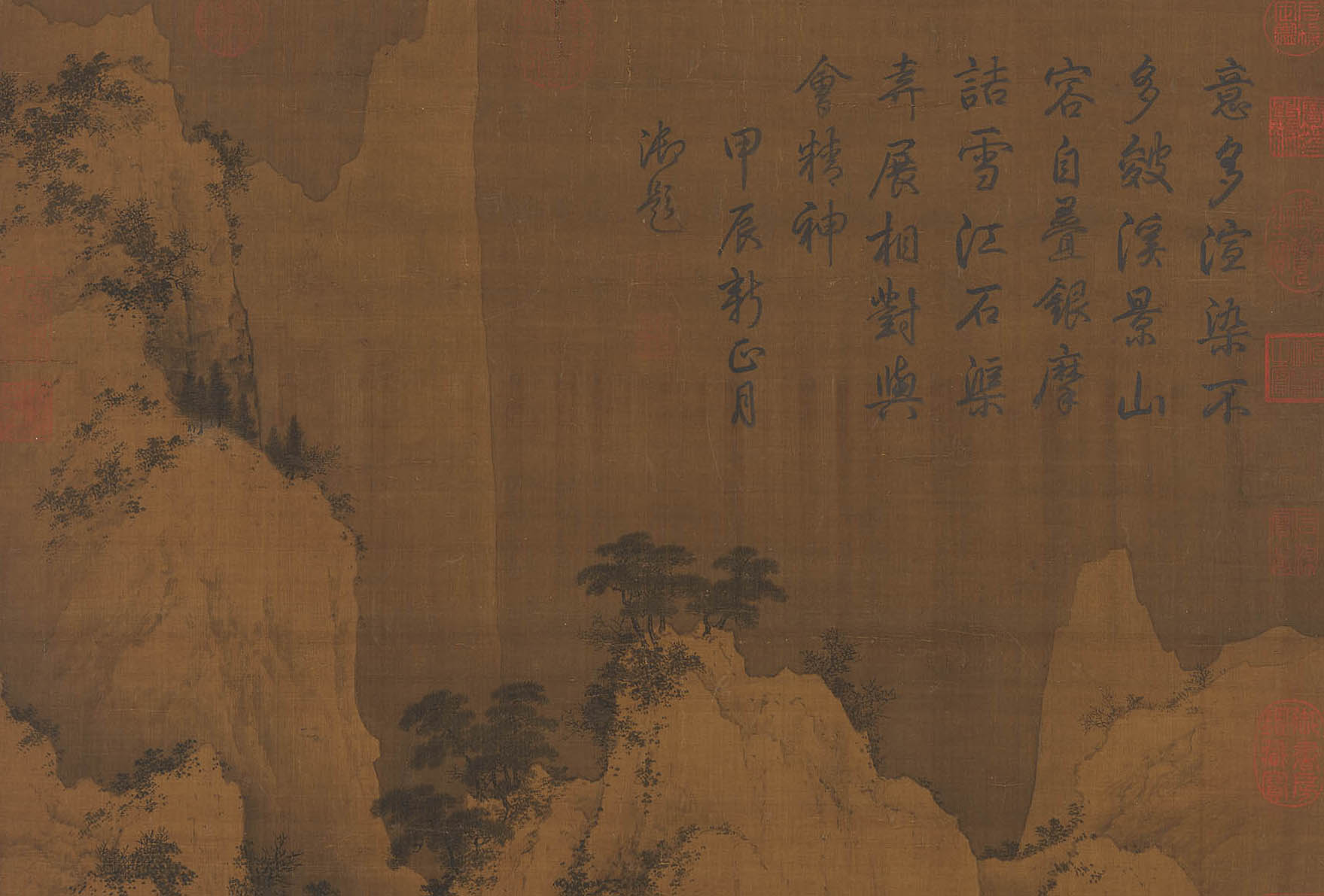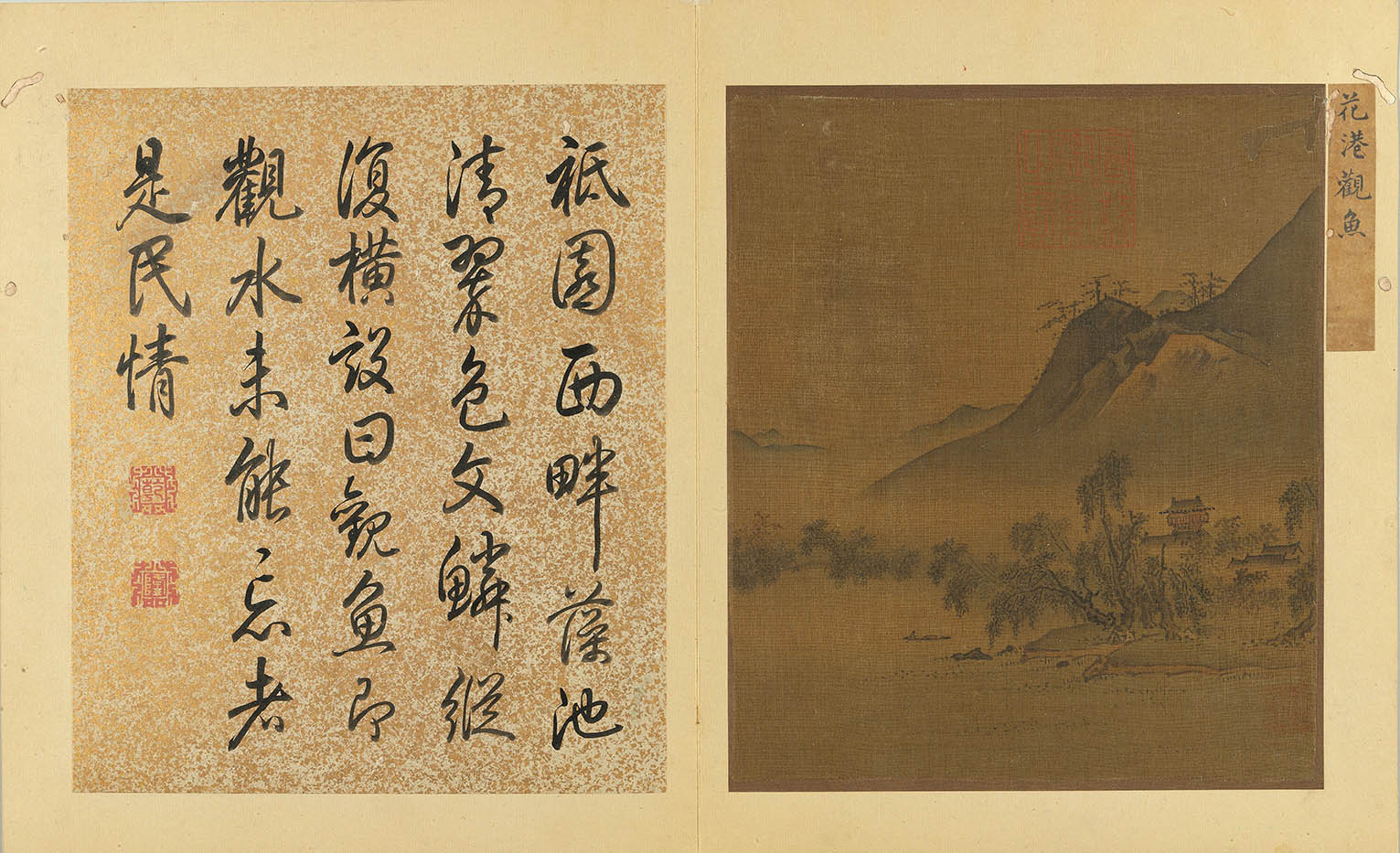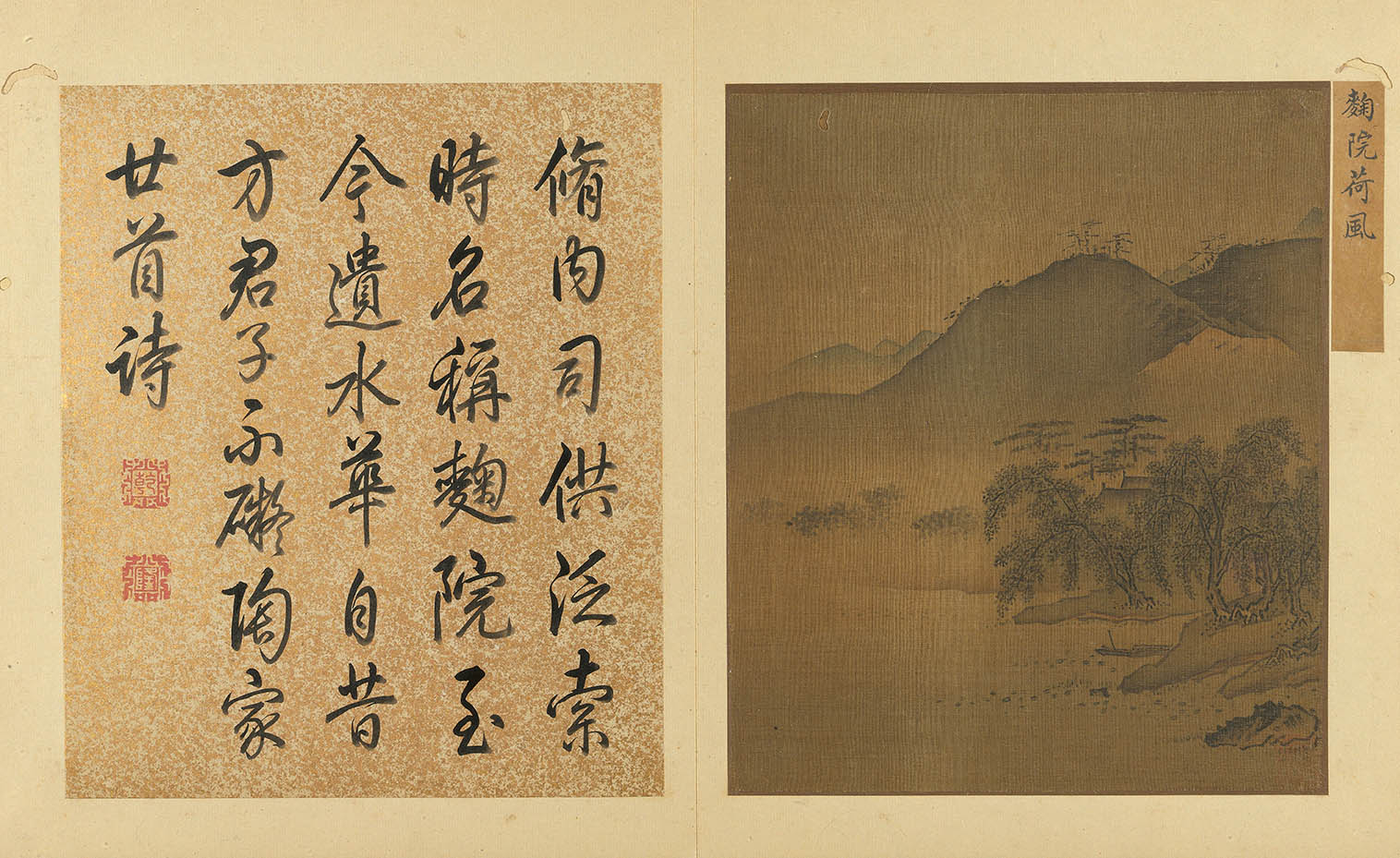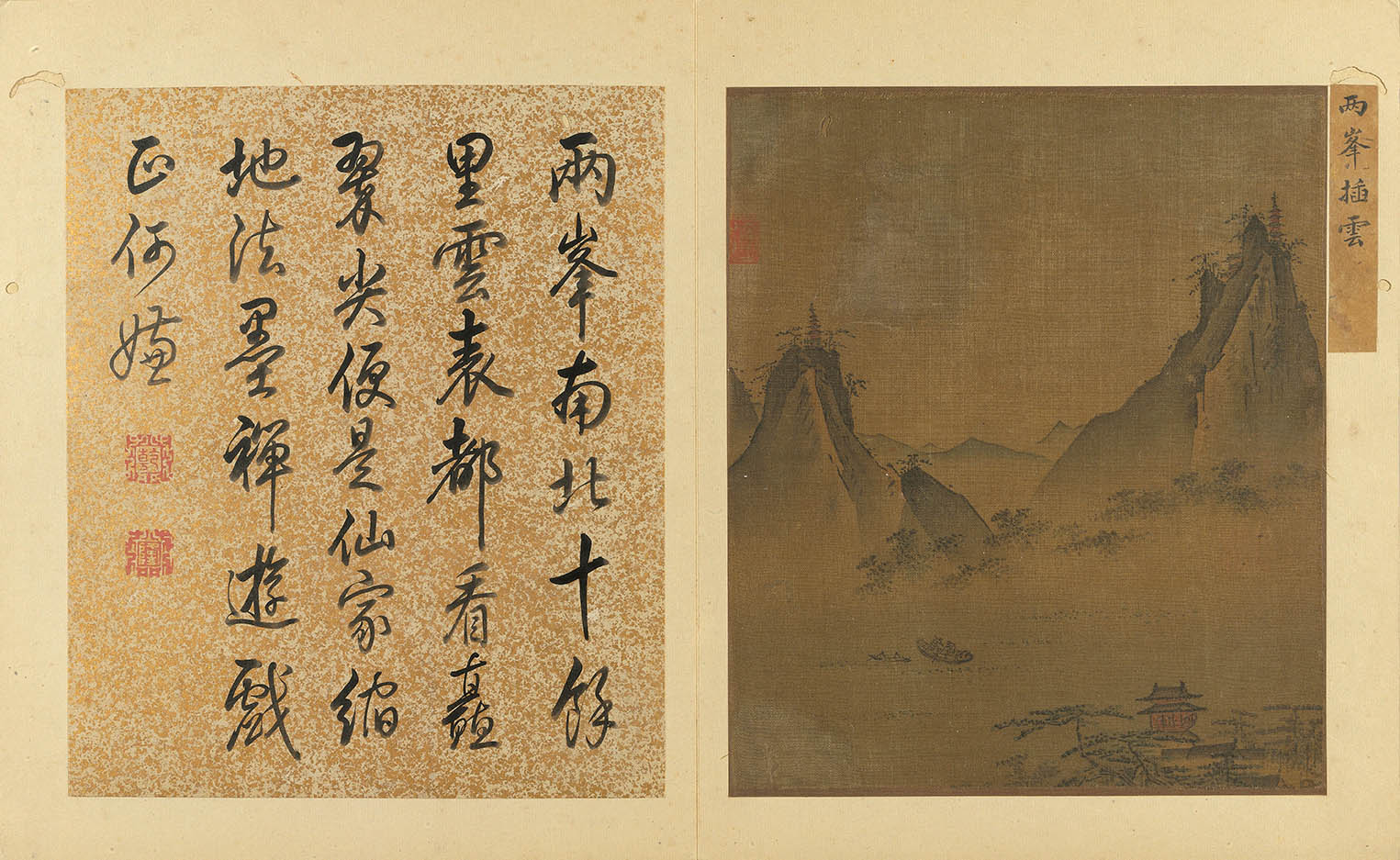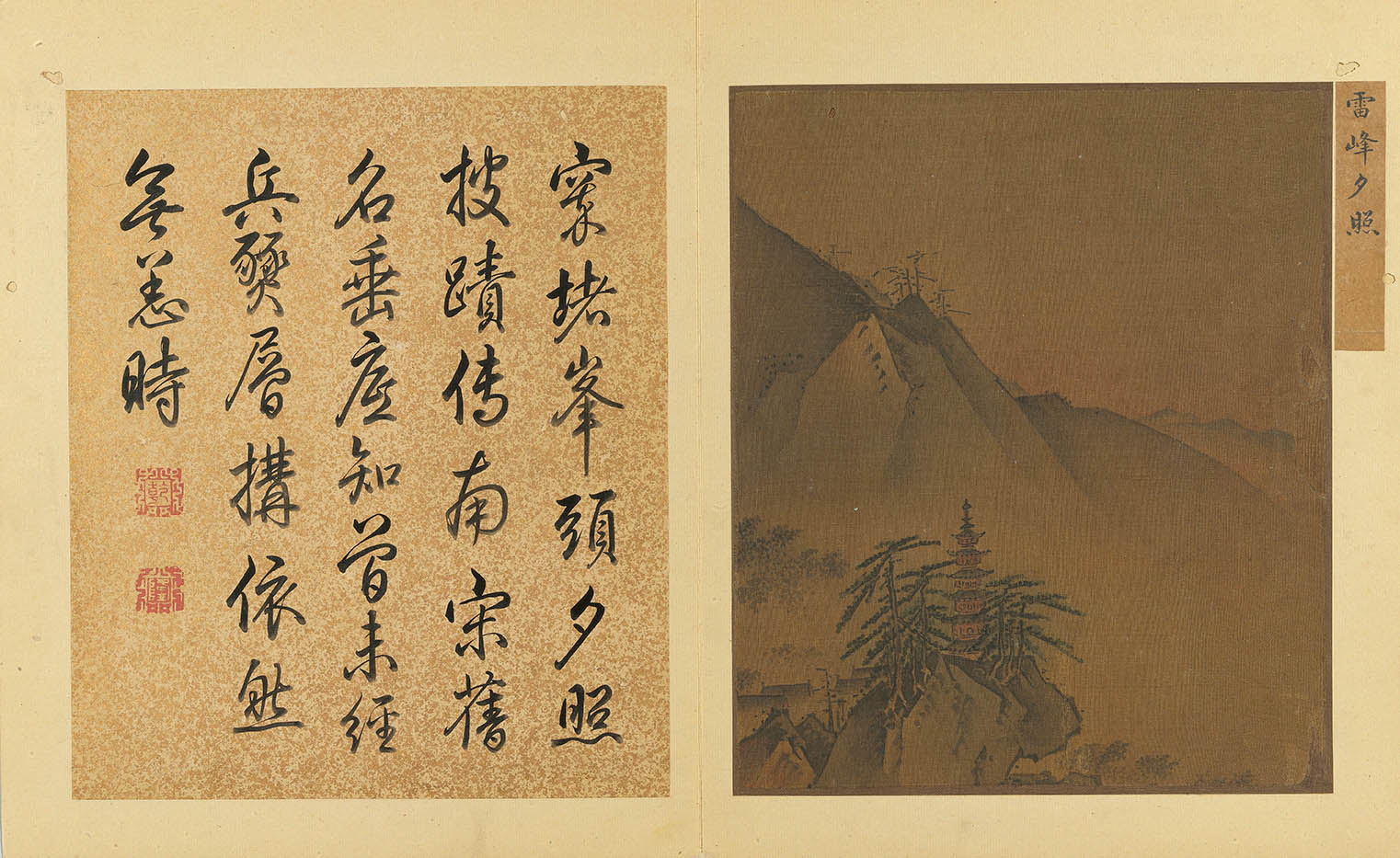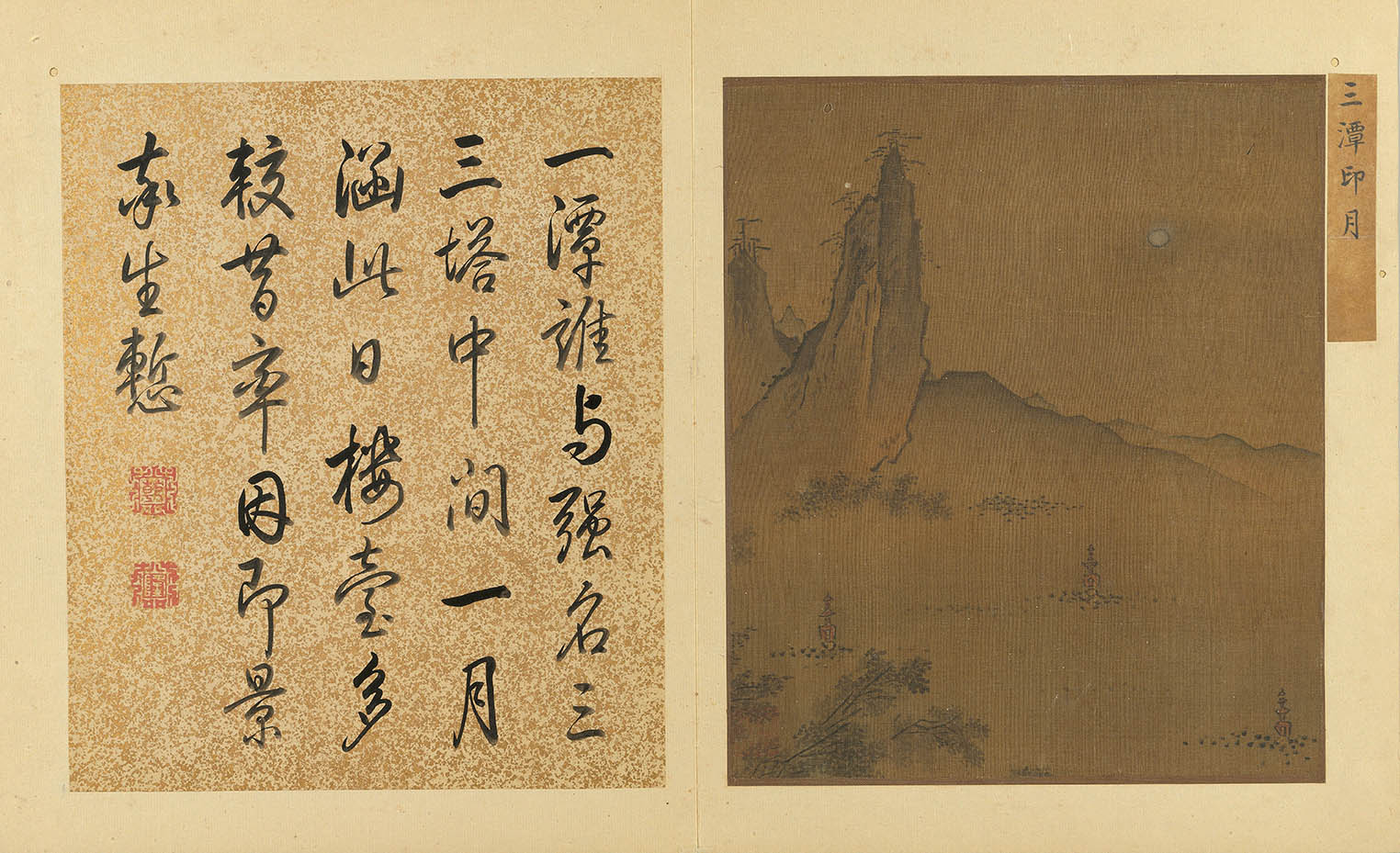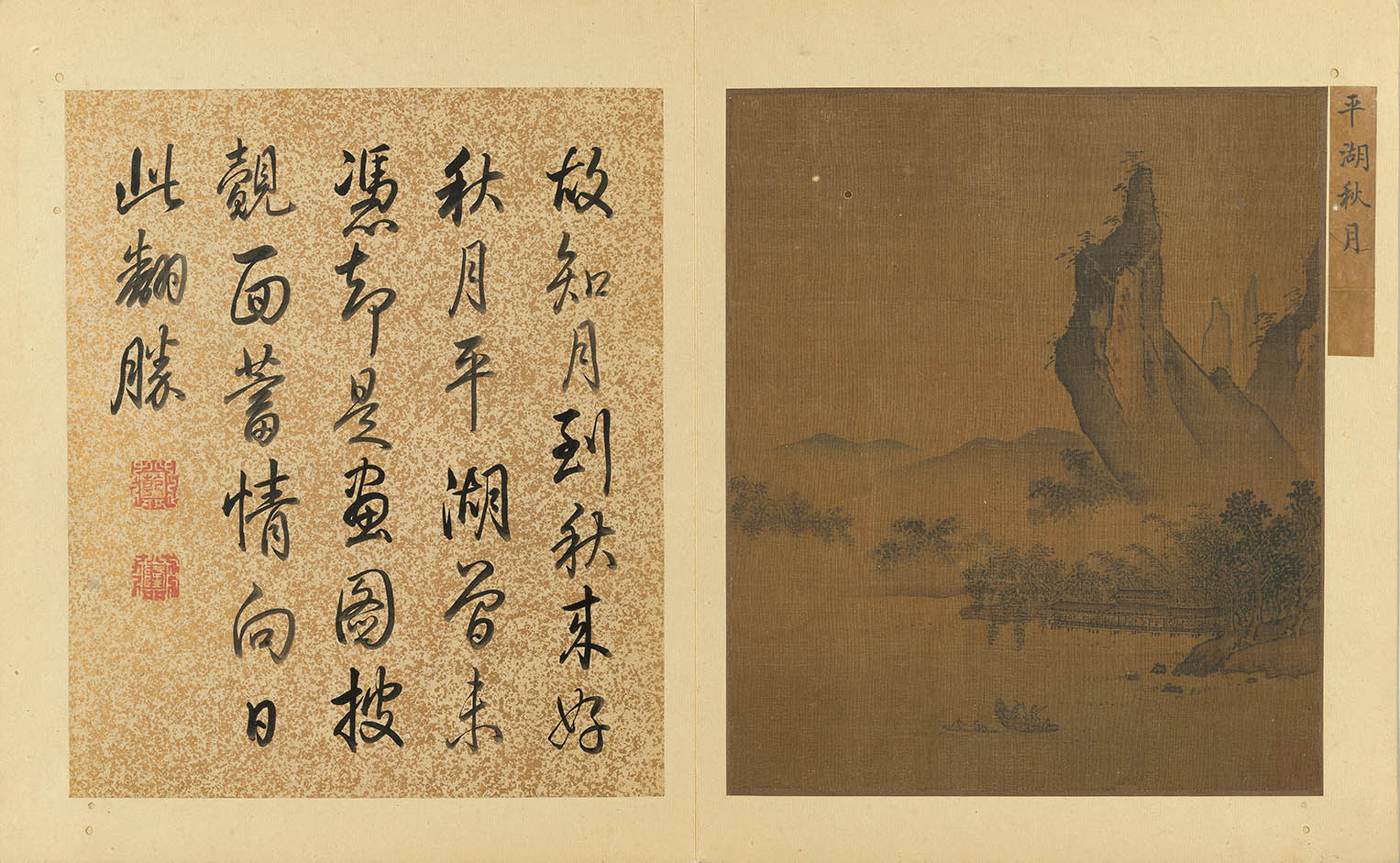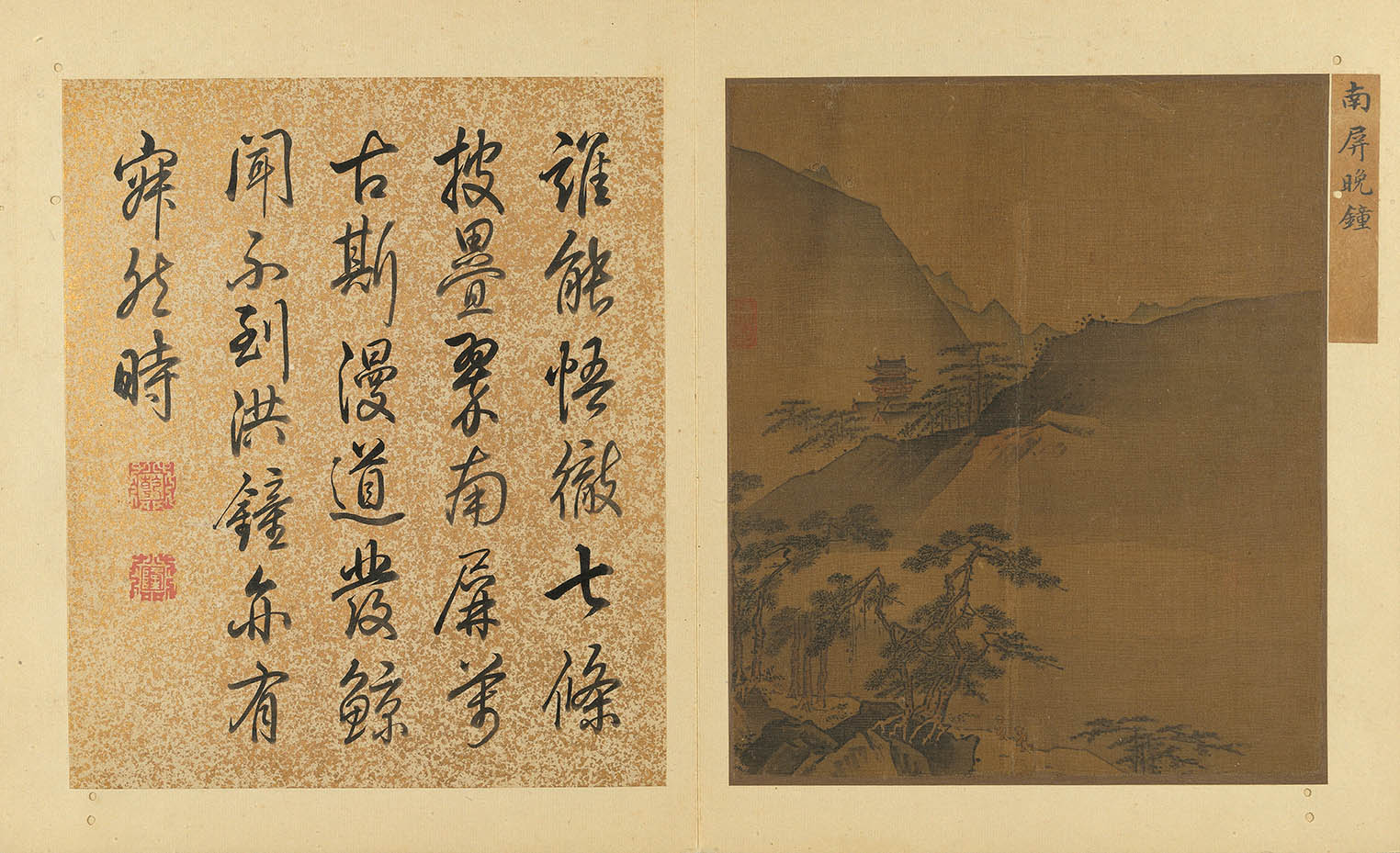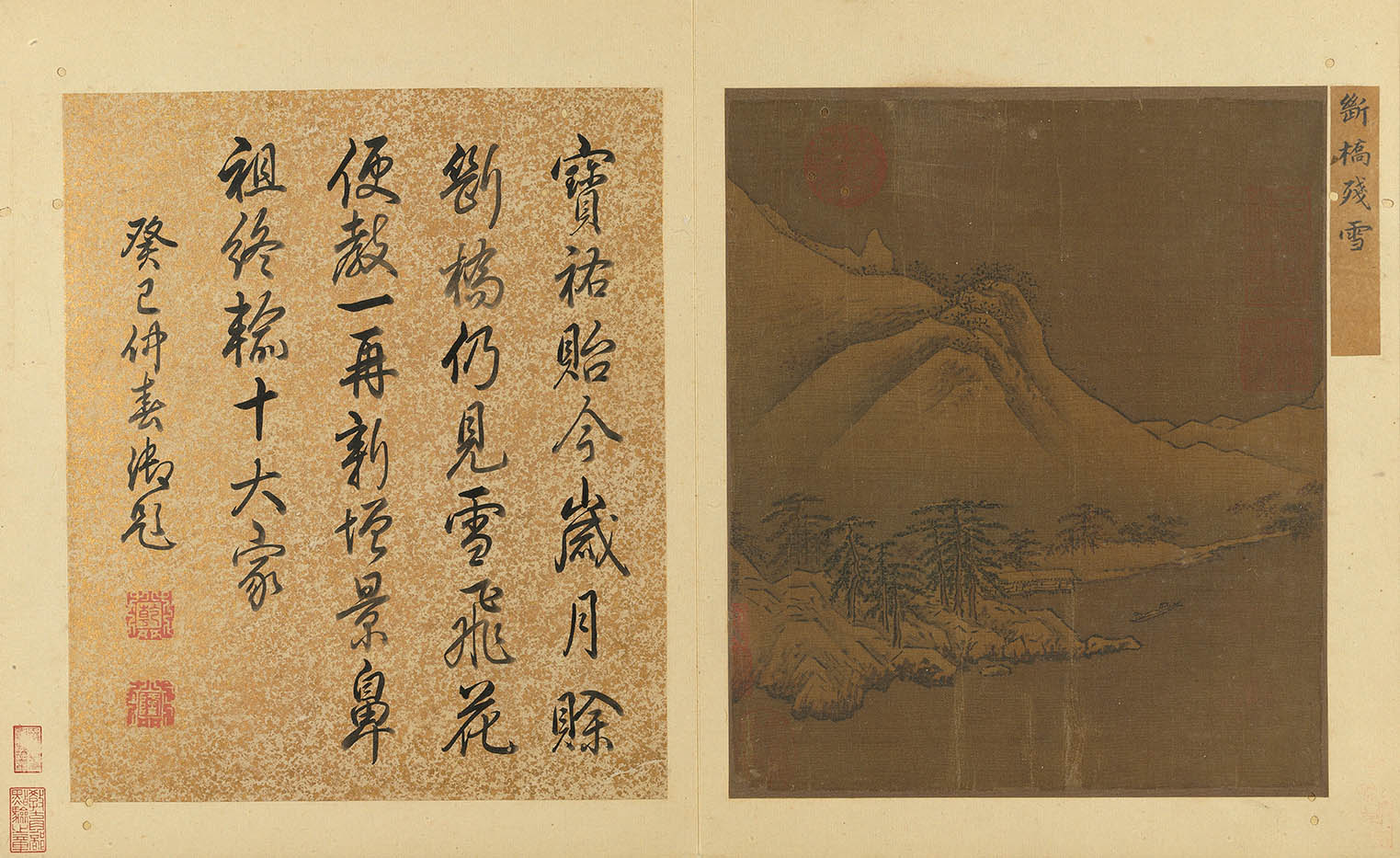The Pure Sounds of Mountains and Rivers
Capital of the Southern Song dynasty, the city of Hangzhou's most striking scenery was immortalized in "Ten Scenes Around the West Lake" and other small landscape paintings. The works, which were fused with depictions of the four seasons and scenery at dawn and dusk, are profoundly unique. This genre of painting was heavily influenced by artistic techniques descending from the Northern Song dynasty's "Eight Views of Xiaoxiang." In this section of the exhibit, a special space entitled "Silent Poems/Aural Paintings" shows two paintings—"Perched atop Boulders, Gazing upon Clouds" and "Dragging a Staff Beneath Pines"—next to one another. The contrast found in their pairing highlights a stance shared by Su Shi and many others during the Song dynasty, that painting is "silent poetry," and poetry is "formless painting" or "painting with sound."
- Snowy Twilight by a Mountain Stream
- Song dynasty, Anonymous
This painting's foreground depicts groves of trees growing streamside on uneven ground. Amid them, a traveler carrying a load makes his way, his head huddled against the cold. Also in the near ground can be seen structures with snow-covered eaves, the gate to the bamboo fence enclosing them left halfway open, with a murder of crows circling above. Across the stream, in the middle ground and half-obscured in the misty foothills, birds play in the water, creating a scene that is at once expansive and indistinct. In the far distance is a cluster of massifs under the clear skies following a snowfall, with a Buddhist temple tucked into a dense convergence of ridges and trees. The furthest mountain, which looks almost as though a paper cutout, stands unilluminated in the falling dusk. This painting's creator is unknown, but its style marks it as likely to be the work of an early Southern Song dynasty artist. One of the landscapes in Northern Song dynasty literati painter Song Di's (ca. 1015-1080) renowned series of paintings, "Eight Views of Xiaoxiang," is entitled "A Snowy Riverscape by Evening." The work on display here is an intentional continuation of the theme of snowy sunsets, but it integrates "small scene" subject matter, creating a remarkable sense of liveliness.
- Ten Scenes Around the West Lake
- Ye Xiaoyan, Song dynasty
The lower left-hand corner of this album's tenth leaf is signed with two characters—"Xiaoyan." Ye Xiaoyan was a painter from Hangzhou who was active during the first half of the thirteenth century. His extant works are few in number, and records of his life are scarce. References to the "Ten Scenes Around the West Lake" subject, which became popular during the Southern Song dynasty, can be found in writings dating to the thirteenth century. The ten scenes included "Spring Dawn at Su Dongpo's Dyke," "Listening to Orioles Under Swaying Willows," "Gazing at the Fish of Flowery Cove," "Lotus-scented Breezes at the Winery," "Twin Peaks Piercing the Clouds," "Sunset Over Thunder Ridge Pagoda," "Three Ponds Imprinted with the Moon," "Placid Lake, Autumn Moon," "The Evening Bells of Nanping Hill," and "Vestiges of Snow at the Broken Bridge." Each painting corresponds to different scenery around the lake, portrayed in lucid and elegant style throughout the four seasons and at different times of day. The Northern Song dynasty album of paintings entitled "Eight Views of Xiaoxiang" originated a genre of paintings that depict famous, real-life locales both night and day at different times of year in order to the elicit poetic sentiments connected to each site. The genre evolved during the Southern Song dynasty, leading to landscape paintings richly imbued with the spirit of the city of Hangzhou.
- Clear Skies After a Snowfall over a Placid Lake
- Anonymous, Song dynasty
The recorded name for this unsigned work is "Clear Skies After a Snowfall over a Placid Lake." Composed in the "leaning to one corner" (bianjiao) manner, this painting is stylistically similar to the works of Southern Song dynasty painter Xia Gui (fl. 1180-ca. 1230). The "placid lake" of the title refers to the serene, mirror-like surface of the lake's water. Small-scale landscapes depicting expansive lakes were a common sight in Southern Song dynasty painting, and it is quite possible that this work was meant to portray the environs of the West Lake in the dynastic capital of Hangzhou. On the far shore are depicted low-hanging willow trees, a bamboo fence, and a snow-covered dwelling hidden in the woods. The painting illustrates the moments when a snowfall ceases and gives way to clear skies, creating the atmosphere of a tranquil redoubt surrounded by nature.
- Perched atop Boulders, Gazing upon Clouds
- Li Tang, Song dynasty
Li Tang (ca. 1070-1150) was a renowned painter who lived during the transition between the Northern and Southern Song dynasties. His "Wind in Pines Among Myriad Valleys," created during at the end of the Northern Song dynasty, portrays layer upon layer of densely packed mountains, painted with "axe-cut" texturing strokes and blue-and-green washes of varying shades applied to the mountains and boulders. The painting transports the viewer into a flourishing pine forest spanning a network of plunging valleys.
The painting displayed here is unsigned. It has traditionally been recognized as one of Li Tang's works, but it is in actuality a Southern Song dynasty work painted in his style. It depicts a pair of eremitic scholars whose peregrinations have taken them to the cusp of the wilds. Perched atop boulders, the two recluses look with pleasure upon the scene of roiling mists before them. From deep within the forest of twisting, verdant pines emanate the sounds of a gushing spring, as clouds surge skywards like steam before the scholars' eyes. Seated creekside, the gentlemen cool their feet in the flowing waters, their manner suggesting unsurpassable joy. Beholding this painting, one feels the pull of the imagery in a couplet in Tang dynasty poet Wang Wei's "Zhongnan Mountains Pied-à-terre." The couplet reads: "We stroll to where the waters meet their end, and sit to witness the moment when the clouds ascend." - Dragging a Staff Beneath Pines
- Attributed to Xu Daoning, Song dynasty
A signature reading "Daoning" can found on this painting's lower left, and it was previously labeled as the work of Northern Song dynasty painter Xu Daoning (ca. 11th century). However, the pine tree, bamboo, and human figure all show the influence Liu Songnian's (fl. late 12th century) painting style, indicating that it was actually created during the late Southern Song dynasty.
This painting depicts a scholar, staff in hand, following a narrow lakeside trail under the shade created by a deep green pine and verdant bamboo. His headdress and sash flutter softly in the wind as the scholar stands still to enjoy the sounds of the soughing pine. Paintings such as this one attempted to use visual art to convey the aural motif of "listening to pines" found in poetry and lyrics—to Southern Song dynasty painters, this subject matter presented no small challenge. Early on, during the Northern Song dynasty, Su Shi and others were devoted to the fusion of poetry, lyrics, and painting. They described paintings as "silent poetry" and poems either as "formless paintings" or "paintings made from sound." This train of thought further developed during the Southern Song dynasty, with the creation of "acoustic paintings."

